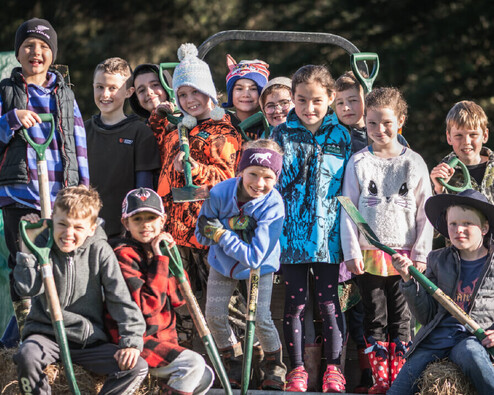
Teacher information
Trees for Survival School Resources
All of our teacher information and supporting resources align Trees for Survival activities with a range of learning outcomes for all ages.
We are excited to be working on a curriculum linked teaching guide and video for teachers use to support their Trees for Survival activities - we will be releasing the first stage of this guide in 2025.
Currently the Trees for Survival programme can be aligned with the following NCEA units: Level 3 Unit+22175v2, 27208v2, 27210v2, 29829v1Level 2 Unit+31656, 21556, 2765, 9681, US2803,29493, 29669.

2M+
Total native plants planted

164,000
Total native plants planted in 2024

213
Schools involved in 2024

7,200
Students involved in 2024

16km
Waterways planted in 2024
Programme resources
Please download and use the guidelines and checklists to provide some additional support for teachers leading the Trees for Survival activities such as potting up and planting days.
Within the Trees for Survival calendar (below) this is plenty of opportunity to align Trees for Survival activities with learning opportunities for all ages around biodiversity, ecology and restoration.
Planting calendar
Along with year-long watering and tending to plants, here is an overview of the yearly Trees for Survival calendar.
August - September
Potting Up
Potting mix and eco sourced native seedlings arrive (approx. 900)
Watch potting up video
Pot up seedlings as soon as possible and before the end of Term 3
Book your Facilitator in to help you with this!
October
Great - seedlings are all potted on!
November - December
Plan summer holiday plant care and watering system checks
Facilitator undertakes pre-summer visit to count plants and check shade house
February
Facilitators post summer visit to count plants and check shade house
Pencil a planting day date and rain date into your school calendar
Advise your Facilitator of your preferred dates!
March
Liaise with your Facilitator around ongoing plant care and shade house checks
April
Facilitators are busy liaising with landowners, assessing and monitoring planting sites and will then confirm site and dates with landowner and school
Liaise with your Facilitator about adjusting your water timer to prepare plants for life after planting day - this will vary depending on seasonal conditions
Planting day prep
Lead up to Planting Day
Make planting day transport arrangements/ bus booking
Send your RAMS form to your Facilitator
Your Facilitator will share further planting day details
Send out Planting Day invitation to adult help
Arrange plant pick up with landowner 1 -2 weeks prior to planting day
Watch planting and safety videos
May - August
Planting Day!
Typically the planting day is a full day out. Arrange to take about 30 students. This number is manageable for landowner catering and facilitator resources.
Please invite adult helpers as they can be a tremendous help. Watch the following videos in preparation for the day: Safety Video and Planting Day Video.
Transport arrangements for the day are the schools responsibility and cost however bus subsidies may be available.
Post-planting day
After Planting Day - before new seedlings arrive
Ensure the landowner returns all crates and planter bags to school promptly.
Clean and tidy up around shade house
Apply moss spray to shade cloth while shade house is empty
Set timer to run for 1 min per week to prevent sprinklers clogging
Teaching Outcomes
There are two components of the Trees for Survival teaching and learning cycle:
Growing and Planting Native Plants
Growing trees requires ongoing attention – there are lots of opportunities to involve students:
Involve the whole class in potting on.
allocate watering and weeding teams
Make the planting day something to really look forward to.
It is best that the teaching curriculum is completed in one year and a planting day planned annually.
Most regions have small seedlings supplied and are able to grow to a planting out size in one year.
plan to plant a minimum of 800 trees
there are plenty of classroom opportunities including counting and recording / identifying native plants / understanding the complexities of habitats
planting days should take place from May to August (September in the deep south)
Late planting often results in poor outcomes, as the roots have not had sufficient time to establish before the following summer, and the dry autumn weather which often follows.
Focus in the Classroom
Classroom activities will reinforce the themes outlined in the environmental education curriculum
education IN the environment
education ABOUT the environment
education FOR the environment
The key outcomes of the programme emphasises the role of trees in:
controlling erosion
improving stream flow and water quality
habitat creation
biodiversity
reducing carbon emissions
Student benefits include:
knowledge of plant parts
recognition of native tree seedlings and adult species
awareness of the basic requirements for plant growth
acquaintance with risks to healthy plant growth ( insect pests, weeds, fungal attack)
experience in ‘potting up’ seedlings
ability to ‘plant out’ established plants in the field
Resources
Guidelines for Environmental education in New Zealand Schools
Endangered Species - Adopt a Stream
Living with the river teaching information
Wakatipu Reforestation Trust Native Environment themed Colouring In Sheets
Department of Conservation Experiencing native trees in your green space
Thanks for a well organised and inspirational day for our children. It really brought out the best in them and will leave them with lasting memories and thoughts about how to make our community and planet a better place.”
– Deputy Principal, Puni School
What does success look like?
We have a range of criteria to set your school up for success so you enjoy the Trees for Survival programme and your students have a great experience. Here's what we're looking to achieve:
The Trees for Survival programme was integrated into the curriculum
Seedlings were potted on as soon as possible after receiving them
Shade house plants are tended throughout the growing season
Planting day dates were set and shared with your Facilitator and Landowner before the end of March
By May, all plants were a minimum of 30cm and sturdy enough for planting between May-Aug
Your planting day may not go ahead if your plants numbers or size are insufficient
If there were substantial numbers of undersized plants or plant losses the reasons for this would be identified with your Facilitator and a plan put in place to prevent this in future
A successful planting day was held with your community and sponsors.




